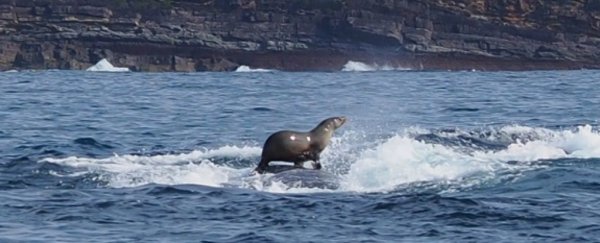Australian photographer, Robyn Malcolm, has captured this incredible photo of a fur seal hitching a ride on the back of a humpback whale off the coast of Eden in southern New South Wales.
Malcolm was on a whale-watching trip when the boat came across a large pod of humpback whales in the midst of a feeding frenzy, but she didn't realise until she looked at her photos later that a seal had been sitting on top of one of them.
"I was surprised to find photos of the cheeky seal in amongst the other shots as I didn't notice him at the time," Malcolm told Lucy Cormack over at The Sydney Morning Herald. "I don't think he stayed there for long."
Humpbacks are baleen whales, which means they don't have teeth. Instead they use their baleen filter system to sift small fish and plankton and krill from the water. Impressively, they can eat up to 1,400 kg of food a day by herding prey into a small area and lunging through the middle with an open mouth.
 Robyn Malcolm/Diimex.com
Robyn Malcolm/Diimex.com
It's for this reason that the seal was most likely hanging around the pod, NSW National Parks and Wildlife expert Geoff Ross told Cormack: "Humpbacks force fish into very tight bait balls, that means everyone can dart through the inside or the middle - anything that makes it easier to catch fish, seals will be involved."
He explained that the behaviour is incredibly rare, but not unheard-of. "The only other time was a seal trying to get away from a killer whale," said Ross. "The seal hopped on the back of the pectoral fins of a humpback whale."
But what's most unusual about Malcolm's photos is the fact that they appear to show the whales bubble-net feeding, a behaviour that was thought to only occur in colder waters.
"They look they are bubble feeding, a very unique behaviour," Ross told The Sydney Morning Herald. "We've not known humpbacks in NSW waters to feed like this, that's the first time I've seen that happen in NSW waters."
When humpbacks hunt by bubble-netting, they swim beneath a shoal of small fish and then rise to the surface in a circular pattern, blowing bubbles as they go. This creates a wall of bubbles that the fish won't swim through, and contains them in one area where they're easier to catch. You can see it in action below:

Right now, humpback whales are making their way down the Australian coast en masse as they head to Antarctica for the summer, resting and feeding as they go, but until now they've never been seen using this hunting technique in the area before. It's something scientists will be keeping an eye out for.
And just in case you're about to cry Photoshop and brush the whole thing off as a hoax, Malcolm assured The Sydney Morning Herald that that wasn't the case. "I'm positive, because I don't know how to use Photoshop," she said. "And I do still have it on the camera so I can prove it."
